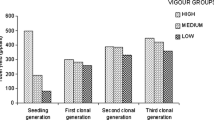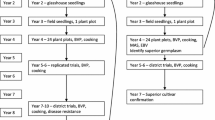Summary
A method for the statistical analysis of binary data (derived from a retain, reject selection process) from incomplete diallel crosses is presented. Based on the fixed statistical model of Griffing (1956), formulae are derived which allow the estimation of parameters and the analysis of variance by weighted least squares. The method results from the application of vector theory to the work of Keuls & Garretsen (1977, 1978). The theory is illustrated by a worked example with data from an incomplete potato diallel cross involving 18 parents, although the method itself is applicable to any crop.
Zusammenfassung
Dieser Artikel beinhaltet theoretische Prinzipien und Methoden für die statistische Analyse eines unvollständigen Diallels, bei der der Anteil von Pflanzen in jeder Nachkommenschaft mit einer höheren Expressivität einer Eigenschaft entsprechend zugeordnet wird. Dies wird als ‘Erfolgsfraktion’ bezeichnet (Formel 1) und ist in Formel 2 transformiert. Griffings Modell mit fixen Effekten (Formel 3) wird hierbei vorausgesetzt. Die Methode der gewichteten kleinsten Quadrate wurde zur Schätzung der Parameter und zur Varianzanalyse verwendet. Die Ergebnisse von Garretsen & Keuls (1973, 1978) und Keuls & Garretsen (1977), die eine Methode zur Analyse quantitativer Merkmale in unvollständigen diallelen Kreuzungen auf der Basis eines Vektorraumes vorschlugen, wurden modifiziert. Die Modifikation beruht auf der Multiplikation eines Schätzraumes mit der Gewichts-Diagonal-Matrix (Formel 5, 6 und 7). Die Varianzanalyse (Tab. 1) berücksichtigt die theoretische Fehlerstreuung (Gleichung 1). Dies erlaubt die Prüfung der Signifikanz aller Effekte in dem Modell, wie GCA (allgemeine Kombinationsfähigkeit). SCA (spezifische Kombinationsfähigkeit) und reziproke Effekte.
Die theoretischen Ergebnisse werden an einem praktischen Beispiel aus einem Zuchtprogramm bei Kartoffeln (Solanum tuberosum) illustriert. Achtzehn Eltern wurden in Form eines unvollständigen Diallels gekreuzt (Tab. 2). Die Ergebnisse der Varianzanalyse zeigt Tabelle 3. Die Signifikanz der SCA-Varianz ist auf eine einzige Kreuzung (60968 x Pentland Marble) zurückzuführen. Die Schätzwerte der GCA-Effekte werden in Tabelle 4 und Abbildung 1 dargestellt. Weil der grösste Teil der genetischen Variation additiv ist, können die Schätzwerte der GCA-Effekte zur Vorhersage der nachkommenschaftswerte und deren Vergleich mit den beobachteten Werten verwendet werden. Die Korrelation zwischen diesen beiden Variablen war hoch (0,89) und wird in Abbildung 2 gezeigt.
Die Methode ist auf jede Pflanzenart anwendbar, erfordert jedoch eine ausreichend grosse Zahl von Nachkommen und Vollgeschwistern innerhalb der Nachkommenschaft, wenn die Schätzungen zuverlässig sein sollen.
Résumé
Cette étude présente les principes théoriques et les méthodes d'analyse statistique du croisement diallèle incomplet, où la variable est la proportion de plants de chaque descendance présentant une expression satisfaisante du caractère.
Cette variable se nommera ‘la proportion de réussite’ (formule 1), qui est transformée selon la formule (2). Le modèle fixe de Griffing (formule 3) est supposé vérifié au cours de cette étude.
On utilise la méthode des moindres carrés avec pondération, pour estimer les paramètres et pour l'analyse de variance. Les résultats de Garretsen & Keuls (1973, 78) et Keuls & Garretsen (1977), qui proposent une méthode d'analyse de caractères quantitatifs des croisement diallèles, ont été modifiés. Cette modification réside dans la multiplication de l'espace estimé, par la matrice diagonale de pondération (formules 5, 6 et 7). L'analyse de variance (tableau 1) prend en compte la variance résiduelle théorique (égalité 1). Cela permet d'évaluer la signification de tous les effets du modèle, c'est-à-dire de la capacité générale à la combinaison (GCA) de la capacité spécifique à la combinaison (SCA) et des interactions.
Les résultats théoriques sont illustrés par un exemple de travail pris dans un programme de sélection de la pomme de terre (Solanum tuberosum).
Dix huit parents sont combinés dans un croisement diallèle incomplet comme indiqué dans tableau 2. L'analyse de variance est indiquée dans tableau 3. La signification de la variation dûe à la SCA est attribuable à un seul croisement, 60 968 x Pentland Marble. Les estimations de la GCA sont portées dans tableau 4 et figure 1. Une grande partie de la variation d'origine génétique étant additive, il est possible d'utiliser les estimateurs de la GCA pour prévoir les valeurs de la descendance, et les comparer aux valeurs observées. La corrélation entre ces deux variables est hautement significative (0,89), et représentée dans figure 2.
Cette méthode est applicable à toute culture, mais requiert und nombre suffisamment important de descendance et de complets à l'intérieur des descendances, pour que les estimateurs soient assez précis.
Similar content being viewed by others
References
Cox, D. R., 1970. The analysis of binary data. Methuen, London/New York.
Curnow, R. N., 1963. Sampling the diallel cross.Biometrics 19: 287–306.
Czyżewicz, Z., 1975. Badanie wartości form rodzicielskich w hodowli nowych odmian ziemniaka. Praca doktorska SGGW-AR.
Fyfe, J. L. & N. Gilbert, 1963. Partial diallel crosses.Biometrics 19: 278–286.
Garretsen, F. & M. Keuls, 1973. Analysis of genetic variation in an incomplete diallel cross. Proceedings section ‘Biometrics in plant breeding’, Eucarpia (Hanover) 24: 35.
Garretsen, F. & M. Keuls, 1978. A general method for the analysis of the variation in complete and incomplete diallels and North Carolina II designs. Part II. Procedures and general formulas for the fixed model.Euphytica 27: 49–68.
Gilbert, N., 1967. Additive combining abilities fitted to plant breeding data.Biometrics 23: 45–49.
Griffing, B., 1956. Concept of general and specific combining ability in relation to diallel crossing systems.Australian Journal of Biological Sciences 9: 463–493.
Kempthorne, O. & R. N. Curnow, 1961. The partial diallel corss.Biometrics 17: 229–250.
Keuls, M. & F. Garretsen, 1977. A general method for the analysis of genetic variation in complete and incomplete diallels and North Carolina II design. Part I. Procedures and general formulas for the random model.Euphytica 26: 537–551.
Rao, C. R., 1965. Linear statistical inference and its applications. John Wiley, Chichester/New York.
Scheffe, H., 1959. The analysis of variance. John Wiley, Chichester/New York.
Tai, G. C. C. & W. A. Hodgson, 1975. Estimating general combining ability of potato parents for field resistance to late blight (Phytophthora infestans).Euphytica 24: 285–289.
Tan, H., 1978. Estimates of parental combining abilities in rubber (Hevea brasiliensis) based on young seedling progeny.Euphytica 27: 817–823.
Werner, E., 1971. Synteza materialów wyjściowych dla hodowli ziemniaków o wysokich walorach kulinarnych.Zeszyty Problemowe Postepow Nauk Rolniczych 118: 27–48.
Author information
Authors and Affiliations
Rights and permissions
About this article
Cite this article
Madry, W., Ubysz-Borucka, L. The investigation of combining ability of potato based on the success fraction of progeny in incomplete diallel crosses. Potato Res 26, 247–259 (1983). https://doi.org/10.1007/BF02357121
Accepted:
Issue Date:
DOI: https://doi.org/10.1007/BF02357121




